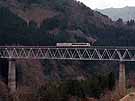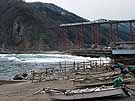
The Takachiho Viaduct, Japan's highest railway bridge, on the Takachiho Railway on 20 March 1997.

A ki ha 65 formation in service for limited express 'Edel Kitakinki' crossing the Amarube Viaduct on 13 February 1997.
I believe many readers will agree that the viaduct is the most
prominent feature of railway scenery. Among Japan's high bridges I like
the Amarube Viaduct (45km northeast of Tottori on the San'in mainline)
best. Although Japan's highest is the Takachiho Viaduct on the
Takachiho Railway(the former JNR Hinokage line, which branches from the
Nippo mainline at Nobeoka, 80km north of Miyazaki) and boasts a height
of 105m, the 41m high Amarube Viaduct, 310m long with its 24 spans
supported by steel trestles, bridging two hills separated by the
estuary of the River Hase, far exceeds it in magnificence. The bridge
was completed in 1912 after 28 months of construction. During the
construction, the steel and lumber for the trestles was manufactured by
American Bridge Company was shipped by way of Moji to the sea area
offshore Amarube as there was no overland approach. Some readers might
remember the tragedy in which an ozasiki-train (with traditional
Japanese interior) fell down from bridge onto a canning factory (the
area is famous for crab meat) owing to a fierce winter gale in December
1986. Now a pagod consecrated to the victims stands on the site. It is
not so easy to get there as there is only a sparse train service
between Hamasaka and Tottori, and only stopping trains call at Amarube.
Still, the bridge is worth visiting.
Another attractive railway feature is a spiral or loop line. The
loops between Yubiso and Doai on the Joetsu mainline (60km northeast of
Takasaki), Shinhikita and Tsuruga on the Hokuriku mainline (135km
northeast of Osaka) and Wakai and Kaina on the Tosa Kuroshio Railway
(which run from Kubokawa, 70km west of Kochi on the Dosan line) are
famous. But the Okoba loop (70km south of Kumamoto) on the Hisatsu
line, of a radius of 300m and combined with a dual switchback, is by
far the best both in scale and scenery. With the opening of the part
between Hitoyoshi and Yoshimatsu in November 1910 what is now the
Hisatsu line (Yatsushiro-Hayato) was completed as a part of the
Kagoshima mainline, which meant the completion of the route between
Moji and Kagoshima. As the part between Hitoyoshi and Yoshimatsu is
mountainous with the 739m high Yatake mountain, it was disadvantageous,
so its status as the trunk route together with the name of the
Kagoshima mainline was taken over by the coastal route opened in
October 1927 and the line was renamed the Hisatsu line. But the old
route is more attractive for railfans as there is a loop at Okoba (the
next stop to Hitoyoshi) and a switchback at Masaki (two stops from
Okoba). Especially Okoba loop, combined with a dual switchback, is
famous and was a very popular shooting spot among railfans especially
in the days of steam when mixed trains hauled by heavy-duty D51s
coupled with banking engines were seen. A train from Hitoyoshi after
stopping at Okoba set back into the second switchback, where it
reversed again to climb the loop making a left-hand curve and going
into Yokohira Tunnel. The loop is of a 300m radius and after the train
came out of the tunnel you could see Okoba station on the left-hand
side. There is a small hill looking down on the switchback and a good
part of the loop near the station. And you could enjoy the view from
the windows of special trains 'Isaburo' (down) and 'Shinpei' (up) both
named after the statesmen who were responsible for opening the line.
But the problem is, as with the Amarube Viaduct, that there is only a
sparse train service, 5 trains each way. Though, the loop is beautiful
with plum blossoms lining the track in early spring.